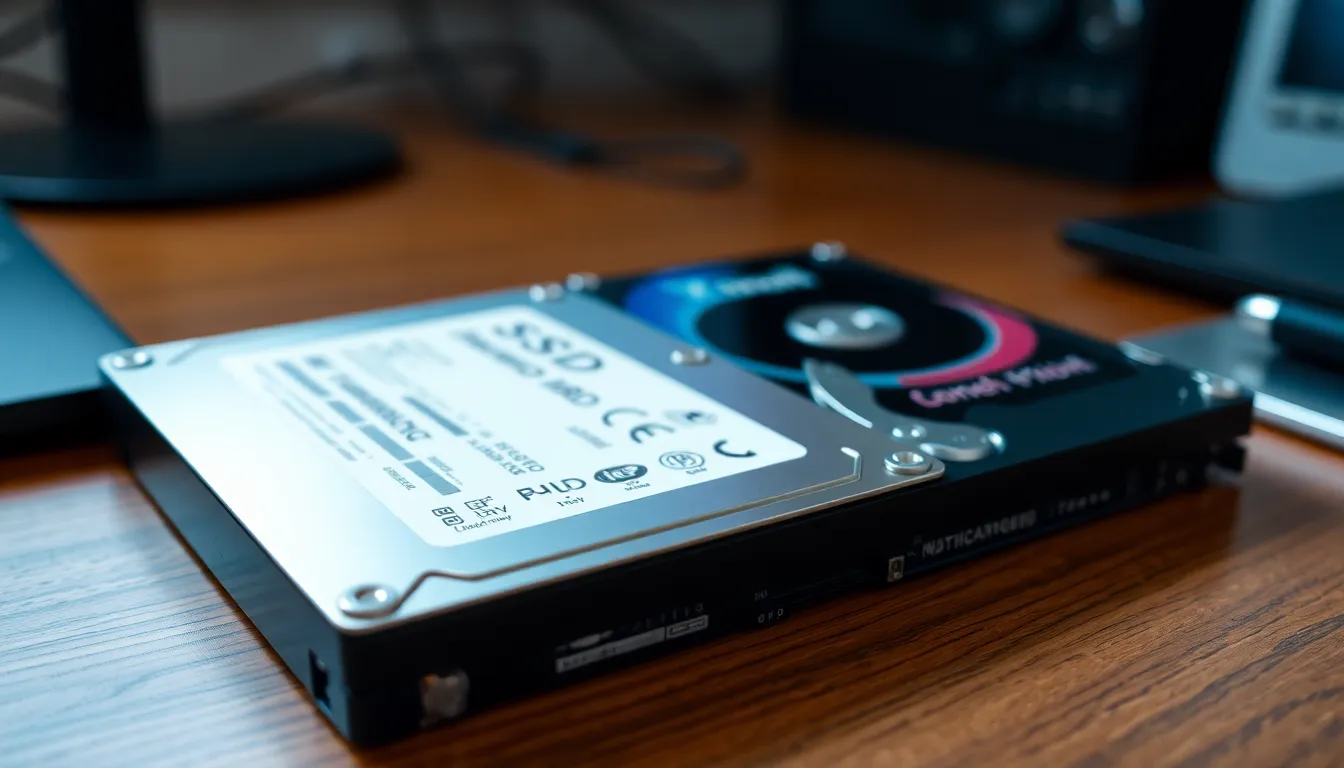In the battle of storage solutions, SSDs and HDDs are like the tortoise and the hare—one’s speedy and sleek while the other plods along with reliable charm. As technology races ahead, choosing between these two can feel like picking a favorite child. Do you want lightning-fast load times or a wallet-friendly option that holds all your cat videos?
Table of Contents
ToggleOverview of SSD vs HDD
SSDs, or Solid State Drives, leverage flash memory to store data. This technology provides superior speed compared to HDDs, which use spinning disks and magnetic data storage. Benefits of SSDs include faster boot times, quicker file transfers, and improved overall performance when running applications.
HDDs, or Hard Disk Drives, still play a significant role in data storage due to their cost-effectiveness. For instance, HDDs typically offer larger storage capacities at lower prices. Users prioritizing budget-friendly options often lean towards HDDs, particularly for mass storage needs.
One major difference is durability. SSDs contain no moving parts, making them less susceptible to damage from drops or shocks. In contrast, the mechanical components of HDDs can lead to failure if not handled carefully.
Another factor to consider is power consumption. SSDs generally consume less power, leading to longer battery life in laptops. Energy efficiency makes SSDs ideal for portable devices.
Performance benchmarks typically favor SSDs in read/write speeds, particularly during tasks that require quick data access. However, HDDs still maintain relevance for archiving large files, thanks to their higher capacity at a lower cost.
Choosing between SSD and HDD often depends on specific use cases. General computing may benefit from the speed of SSDs, while extensive media storage might suit HDDs better. Understanding these differences allows users to make informed decisions tailored to their storage needs.
Performance Comparison

SSDs and HDDs exhibit distinct performance characteristics that influence user choice. Speed and access times significantly differentiate these two storage solutions.
Speed and Access Times
SSDs provide outstanding speed advantages with their flash memory technology. Boot times for systems using SSDs typically range from 10 to 30 seconds, while HDDs can take up to a minute or more. Quick access times are evident in SSDs, often under 0.1 milliseconds, compared to HDDs that operate around 5 to 10 milliseconds. These rapid access times benefit users engaged in tasks requiring immediate data retrieval, such as gaming or video editing. Durability also adds to the advantages of SSDs, as they lack moving components. Thus, users can expect faster performance and reliability across various applications with SSDs.
Data Transfer Rates
When comparing data transfer rates, SSDs outperform HDDs by significant margins. Sequential read speeds for SSDs can exceed 500 MB/s, while HDDs average between 80 to 160 MB/s. This disparity becomes crucial during heavy file transfers, where SSDs complete tasks faster due to superior technology. Additionally, random read and write speeds show similar advantages for SSDs, enhancing multitasking efficiency for users. HDDs, while slower, still serve budget-conscious users with adequate performance for large file storage. Understanding these transfer rates helps determine the best storage solution based on specific needs.
Cost Analysis
Cost plays a significant role in choosing between SSDs and HDDs. Understanding the financial implications helps consumers make informed decisions.
Initial Purchase Price
The initial purchase price for SSDs is notably higher than that of HDDs. A typical 1TB SSD can range from $100 to $150, while a comparable HDD costs around $40 to $60. Users looking for affordable options may find HDDs provide greater value upfront. Despite the higher cost, many see SSDs as an investment due to their speed advantages and durability. Costs fluctuate based on brand and technology, yet HDDs consistently represent a budget-friendly choice for large storage needs.
Cost Per GB
Cost per gigabyte further distinguishes SSDs from HDDs. SSDs generally range from $0.10 to $0.15 per GB, making them more expensive compared to HDDs, which can drop to $0.03 to $0.06 per GB. Users desiring extensive storage on a budget often gravitate towards HDDs. On the flip side, SSDs deliver performance benefits justifying their higher cost. Evaluating the total cost and performance provides clarity for consumers weighing storage options.
Durability and Reliability
Durability and reliability are crucial factors in comparing SSDs and HDDs. SSDs possess advantages due to their lack of moving parts, leading to greater resistance to physical shocks and impacts.
Lifespan and Wear
SSDs typically last up to 5 to 10 years with normal usage, while HDDs may last around 3 to 5 years. Flash memory in SSDs experiences wear from write cycles, but advances in technology mitigate degradation. Users can also enable wear leveling to extend SSD lifespan further. In contrast, HDDs face mechanical wear due to spinning disks and flying read/write heads, making them more vulnerable to failure over time.
Failure Rates
Failure rates markedly differ between SSDs and HDDs. SSDs report lower failure rates, around 0.5% to 1% annually, compared to HDDs, which can reach 2% to 5%. Mechanical components in HDDs are prone to issues like head crashes and platter damage. Statistical analyses indicate that while HDDs may be reliable for mass storage, their failure risks escalate with age and usage. Understanding these reliability differences guides consumers in selecting the best storage solution for their needs.
Use Cases and Recommendations
Understanding the specific use cases for SSDs and HDDs helps users make informed decisions based on performance and storage needs.
Best Uses for SSDs
SSDs excel in scenarios requiring quick data access and high performance. Gaming benefits significantly from SSD technology, allowing for faster load times and smoother gameplay. Professionals engaged in video editing or graphic design appreciate the rapid file transfer speeds that SSDs offer, streamlining their workflow. General computing also sees an uplift in performance, with applications opening almost instantly. Users who prioritize system responsiveness and require reliable boot times gravitate toward SSDs, making them ideal for everyday tasks and demanding applications.
Best Uses for HDDs
HDDs serve well in situations where budget and storage capacity take precedence over speed. Extensive media libraries, such as collections of videos or photos, find a perfect home with HDDs due to their larger storage sizes at a lower cost. Businesses focused on data archiving or backup solutions can rely on HDDs for cost-effective mass storage. Many users who need to store large volumes of documents, music, or extensive software find HDDs advantageous due to their affordability per gigabyte. In short, HDDs remain a solid choice for users prioritizing capacity and cost over speed.
Choosing between SSDs and HDDs ultimately hinges on individual needs and priorities. For those seeking speed and performance SSDs stand out as the superior option. They offer faster boot times and quicker file transfers making them ideal for gaming and demanding applications.
On the other hand HDDs provide a cost-effective solution for users focused on storage capacity. Their affordability makes them suitable for large media libraries and data archiving.
Understanding the differences in speed durability and cost can help users make informed decisions that align with their specific requirements. Whether opting for the rapid efficiency of SSDs or the expansive storage of HDDs each choice has its unique advantages.





